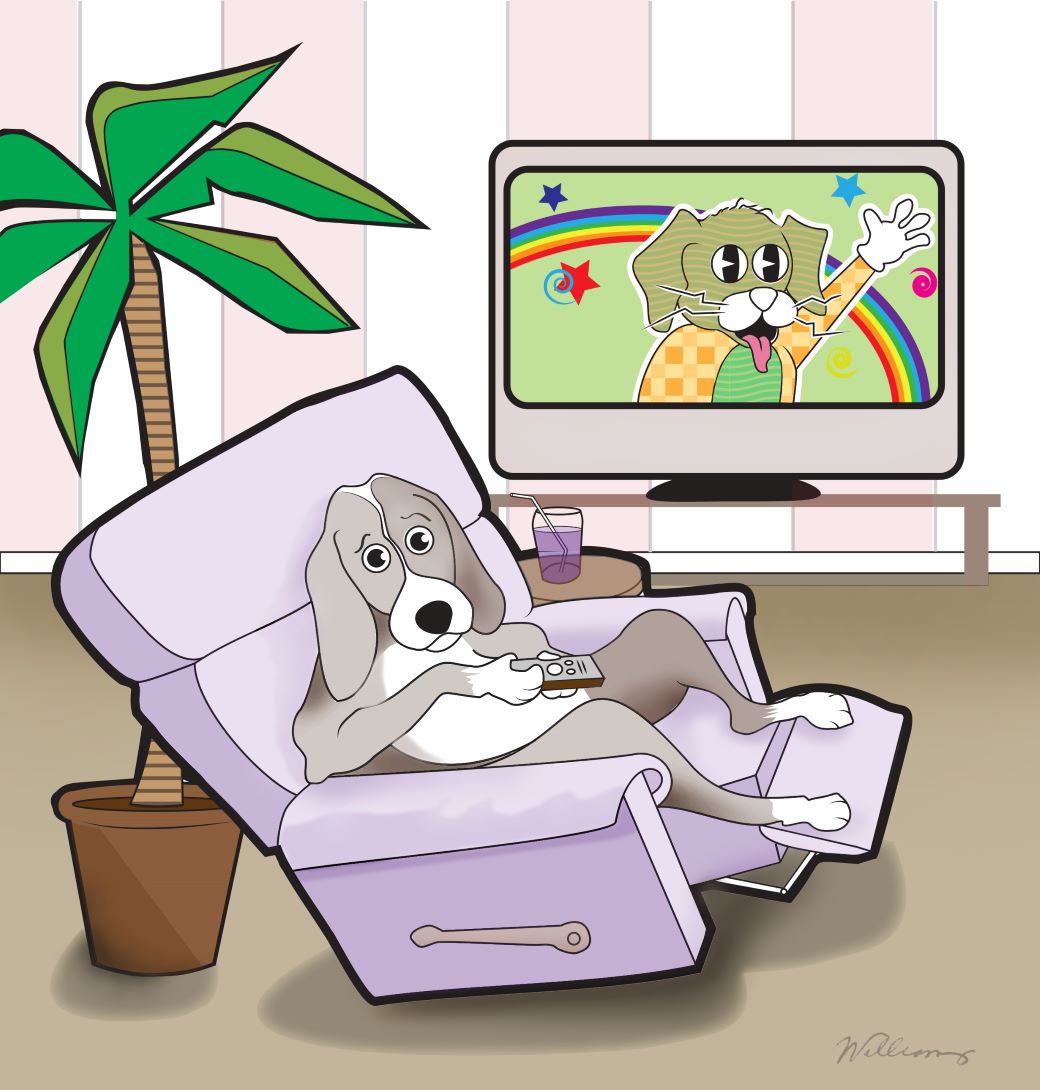 Listen to this story.
Listen to this story.
Dog tv

Illustration by Jon Williams
Suppose you wanted to know whether dogs around the world watch television and, if they do, what interests them most. You can't exactly ask dogs, since they don't speak human, so Dr. Freya Mowat did the next best thing — she asked their owners.
From 31 countries but predominantly the United States, 1,600 dog lovers responded to an online survey posted in 2022 by Mowat, a veterinary ophthalmologist, and her research team at the University of Wisconsin School of Veterinary Medicine.
The findings, published this month in the journal Applied Animal Behaviour Science, tell us this: Far and away dogs' favorite thing to watch is ... other dogs! Even cartoon dogs.
"It makes sense that dogs like watching their own species," Mowat said in an interview. But cartoons? That was a surprise. "I thought that would be too out there," she said.
One might wonder whether the research itself is a bit "out there," but it wasn't idle curiosity that motivated Mowat and her team. An assistant professor at the University of Wisconsin — with appointments in the veterinary school's Department of Surgical Sciences as well as the School of Medicine and Public Health's Department of Ophthalmology and Visual Sciences — Mowat was considering ways to evaluate patients' vision over time. Determining how well they track images on a screen is one possible way.
Before that step, the doctor needed to know whether dogs are apt to track images on a screen at all. The study suggests that indeed they do — although not all dogs, and their level of interest varies. For detailed analysis, Mowat focused on the responses of 1,077 owners whose dogs were active "watchers" on television of things such as animals, sports and/or vehicles.
The dogs were almost equally divided between males and females, and most (82%) were castrated or spayed. The group predominantly was young. One-year-olds comprised the single largest age group, and only 24% were 8 years or older.
Could diminished vision explain why older dogs seem less interested in TV? Mowat is intrigued by the age factor but said she didn't have enough data on older dogs to tell. Another possibility she put forth is that older dogs have just figured out that images they see on screens aren't real and, therefore, not worth attending.
Even the watchers generally don't watch for long. Mowat suggested that they're really "glancers." Half paid attention to screens for one to five minutes at a time. Some couldn't be bothered for more than a minute, while some watched up to 20 minutes.
"Very few dogs paid attention for more than 20 minutes, although owners occasionally commented that dogs would sit and watch a whole movie and appeared to actively engage with the content and react to certain parts of the plot," the study authors wrote.
One movie that five owners named as a favorite is Disney's The Lion King, Mowat told the VIN News Service. The 1994 animated movie — remade and released in 2019 as a photorealistic film — tells the story of a lion cub, Simba, who leaves his pride after his father is killed, his life in exile and his eventual journey home.
"One person said their dog would watch it multiple times and got upset at the same point in the movie every time," Mowat said — when the cub finds his dying father.
Is TV suitable for dogs left on their own?
Noting that dogs reportedly frequently become excited while watching TV — running, jumping or barking, for example — the study authors suggest that "owners may wish to determine whether video content would be suitable for use when their dogs are left alone."
Asked whether they mean that it's a good thing that dogs become stimulated and presumably entertained — as opposed to being left bored — or a bad thing because they might become stressed and even destructive while unattended, Mowat said it could go either way.
"Every dog is different," she said, elaborating that whether owners should let their dogs watch is a conscious decision they should make based on knowing how their dog reacts and whether that reaction is desirable.
The point is that dogs may not find TV-watching relaxing as it typically can be for people. But again, every dog is different. "There was one person who said the dog did use the TV as the way to relax, and the dog had figured out how to use the recliner chair and pushed the button and like, lay down on the recliner," Mowat said. "That was my favorite one."
Affirmation that many dogs do seem to enjoy television is gratifying to the people at DogTV, a company in Israel operating a worldwide streaming channel that is "designed to alleviate your pup’s stress and anxiety throughout the day," according to its website.
"This is a study that we should have paid for!" exclaimed an enthusiastic Dr. David Haworth, a veterinarian adviser at DogTV and a member of its board of directors. He quickly added, "The problem is, any time a corporation is involved in a study, it should be scrutinized for bias" — a recognition of the value of independent research. The study in this instance was funded by grants from the University of Wisconsin and the federal government.
Haworth acknowledged in an interview that programming for DogTV is based on conjecture about what may interest or benefit dogs, but it does follow the guidance of experts such as behaviorists. For example, he said, some soundtracks feature "low, low-level triggering events like thunder and fireworks" as a means of habituating dogs so they learn to handle the real thing.
As for the concern that watching TV may be overstimulating, Haworth said DogTV, which has been in operation for 12 years, has not heard from pet owners with that problem. "Literally hundreds of millions of viewing hours have not elicited complaints of, 'Hey, my dog ripped the TV across the wall because your programming showed a tennis ball floating across [the screen],' " he said, adding, "The absence of data is not data, but sometimes the absence of data can give you an indication. If this was a widespread problem, we probably would have heard about it by now."
Still, Haworth said, "We highly encourage, when you get your subscription to DogTV ... to watch it with your dog. Don't walk away aimlessly."
Any risk to their vision?
Given dogs' interest in television, is there a danger of turning them into screen-viewing addicts? And could screens be bad for their eyes, as they are proving to be for people's eyes?
University of Wisconsin Mowat Lab video
Dr. Freya Mowat and her research team have been inviting dogs into the laboratory to see whether results of their recent survey are reproducible outside the home. This golden retriever seems clearly interested in the dog trotting across a screen.
The ophthalmologist isn't worried. For one thing, dogs usually don't watch for long. Presumably, Mowat said, they believe what's on the screen is real, and "when it turns out not to be real or if [they] ... find something else in the room that's more interesting, then they disconnect. Maybe," she mused, "they're better at disconnecting from screens than we are."
Secondly, dogs generally watch from farther away than people using computers or smartphones. "Obviously, we're sitting at reading distance from the screen, so ... we're quite close," Mowat said. Most dogs represented in the survey watched screens from between two and eight feet away, according to the study.
There's always the exception, of course. "One lady emailed me and said that her dog could scroll with his nose," Mowat recalled with a chuckle, "so there are some outliers there of, like, social media addicts on the dog front, too."
The vast majority of dogs (95%) were interested in watching animals. Most (87%) engaged when seeing other dogs. A solid majority (60%) also showed interest in wild animals, cats, horses or other livestock. Perhaps strangely, barely more than half indicated interest in squirrels.
But squirrel-watching far outpaced interest in people-watching (35%). "It made me laugh that humans ranked so low," Mowat said.
In the category of "other" content, including video games and moving water, cartoons drew the greatest interest. However, as a percentage of all screen-viewing dogs, only 26% were into cartoons.
Besides parsing TV-watching dogs by sex and age, the researchers analyzed their interest in screens by breed. Among purebreds, the breeds most reported to engage with screens were sporting and herding dogs.
One thing the study didn't determine was what proportion of all dogs tend to watch screens. Because survey respondents were self-selected, the research "very likely oversampled responses from owners who cohabited with 'watchers,' " the authors noted. Another limitation is that information provided by owners was subjective. Further, the authors point out, "dogs are more likely to watch what humans watch on screens and are potentially interested in other content that the owners do not expose them to."
For now, the prospect for developing a vision test useful in general practice is undetermined. While even a short period of interaction with a screen is enough for clinicians to glean helpful information about a patient's eyesight, Mowat said, if the patient won't interact at all, that's an impediment.
In the laboratory, "Some dogs don't do anything," she said. "They just look at the ceiling."